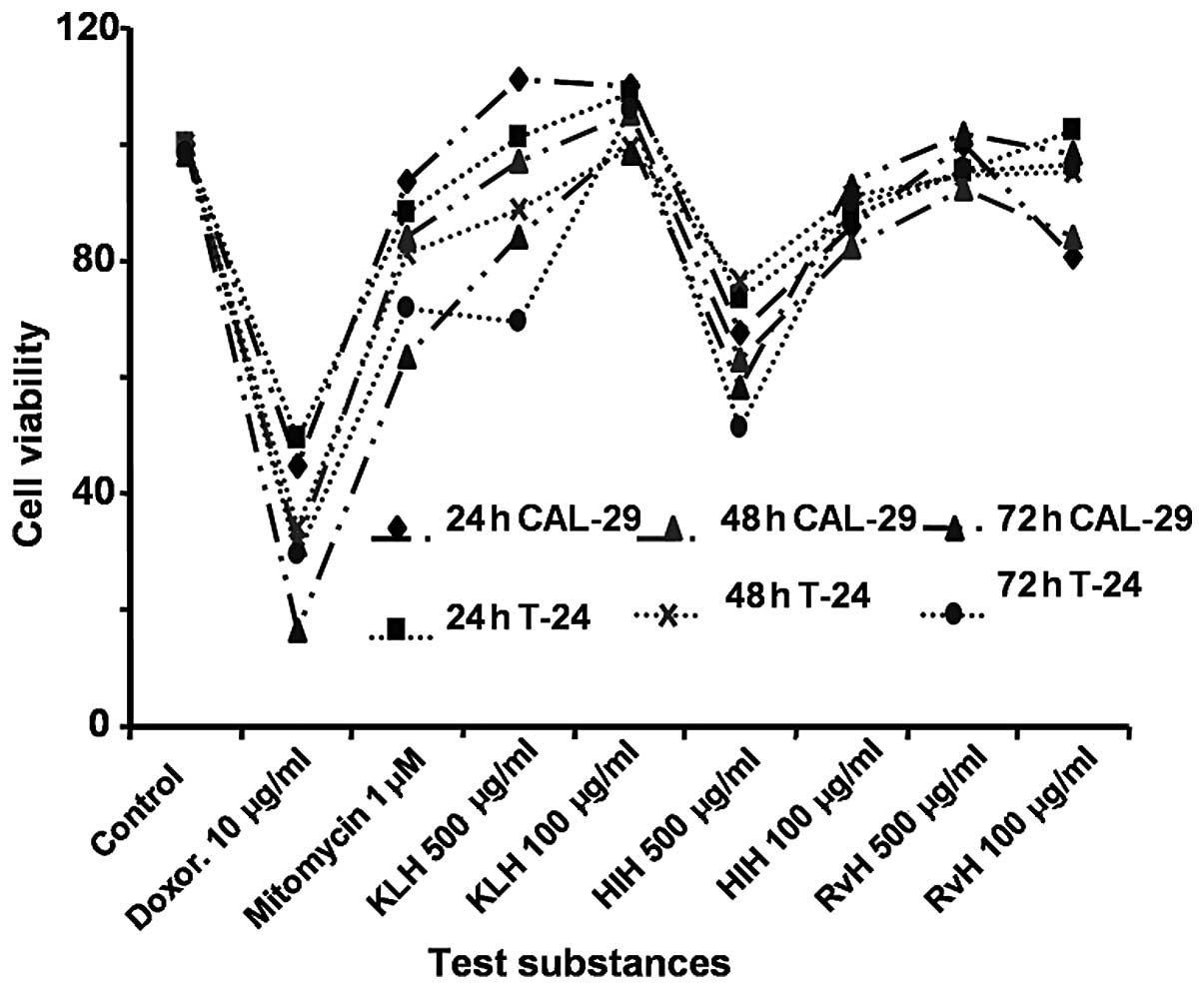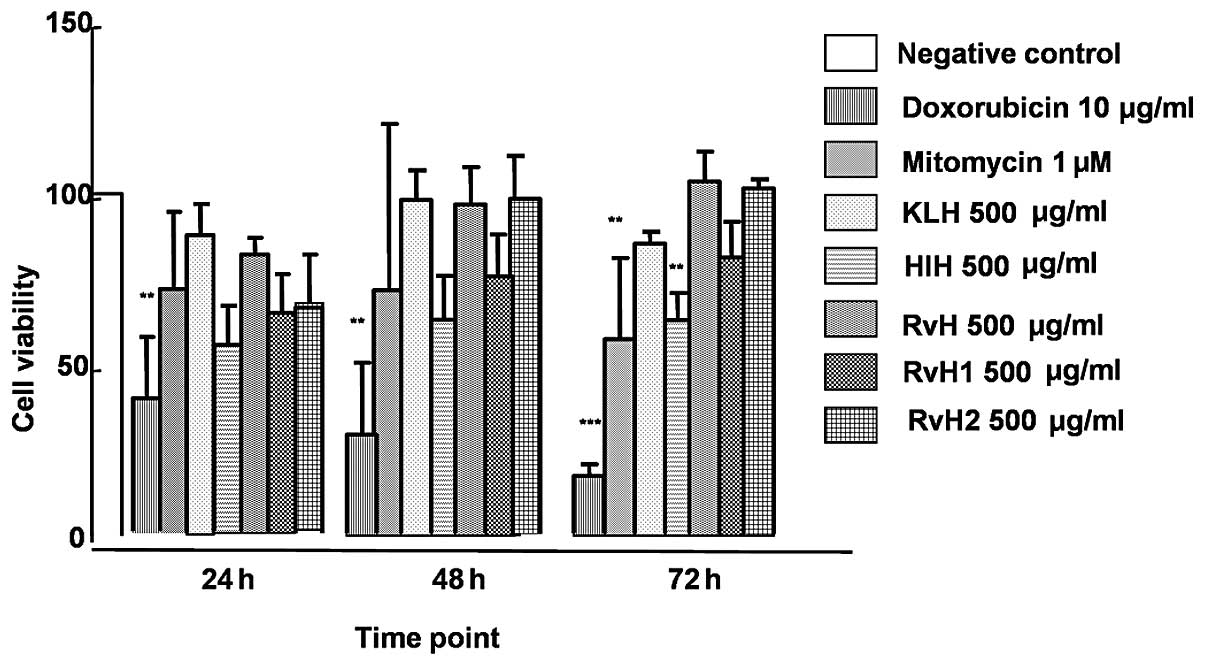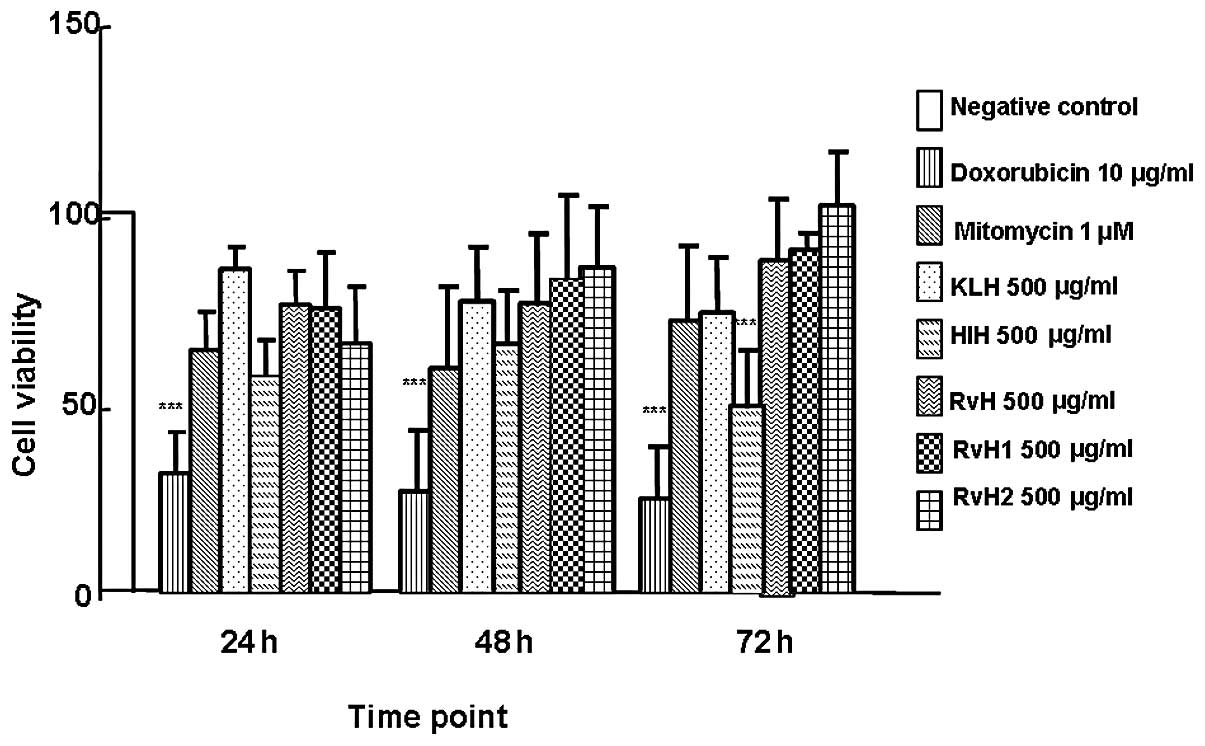|
1
|
Kochanek KD, Xu J, Murphy SL, Miniño AM
and Kung H: Deaths: preliminary data for 2009. Nat Vital Stat Rep.
59:2011.(Available at: http://www.cdc.gov/nchs/data/nvsr/nvsr59/nvsr59_04.pdfuri).
|
|
2
|
Palou J: Patient risk profiles: prognostic
factors of recurrence and progression. Eur Urology. 41:105–112.
2002.
|
|
3
|
US National Institutes of Health: Keyhole
limpet hemocyanin compared with doxorubicin in treating patients
with bladder cancer. http://clinicaltrials.gov/ct2/show/NCT00006034uri.
Accessed March 3, 2011.
|
|
4
|
Dolashka-Angelova P, Dolashki A, Savvides
SN, Hristova R, Beeumen JV, Voelter W, Devreese B, Weser U, Di Muro
P, Salvato B and Stevanović S: Structure of hemocyanin subunit
CaeSS2 of the crustacean Mediterranean crab Carcinus
aestuarii. J Biochem. 138:303–312. 2005. View Article : Google Scholar : PubMed/NCBI
|
|
5
|
Wirguin I, L.Suturkova M, Briani C and
Latov N: Keyhole limpet hemocyanin contains Gal(beta 1-3)-GalNAc
determinants that are cross-reactive with the T antigen. Cancer
Immunol Immunother. 40:307–310. 1995.PubMed/NCBI
|
|
6
|
Li Y, Rabello ALT, Simpson AJG and Katz N:
The serological differentiation of acute and chronic Schistosoma
japonicum infection by ELISA using keyhole limpet haemocyanin as
antigen. Trans R Soc Trop Med Hyg. 88:249–251. 1994. View Article : Google Scholar
|
|
7
|
Burke GP, Smith KA, Stocking RIG, Ferm M
and McIntyre OR: Anti-keyhole limpet hemocyanin antibody in normal
unsensitized individuals. J Allergy Clin Immunol. 59:309–313. 1977.
View Article : Google Scholar : PubMed/NCBI
|
|
8
|
Hortobagyi GN, Smith TL, Swenerton KD,
Legha SS, Buzdar AU, Blumenschein GR, Gutterman JU and Hersh EM:
Prognostic value of prechemotherapy skin tests in patients with
metastatic breast carcinoma. Cancer. 47:1369–1376. 1981. View Article : Google Scholar : PubMed/NCBI
|
|
9
|
Dolashka P, Velkova L, Iliev I, Beck A,
Dolashki A, Yossifova L, Toshkova R, Voelter W and Zacharieva S:
Antitumor activity of glycosylated molluscan hemocyanins via Guerin
ascites tumor. Immunol Investig. 40:130–149. 2011. View Article : Google Scholar : PubMed/NCBI
|
|
10
|
Dolashka P, Genov N, Pervanova K, Voelter
W, Geiger M and Stoeva S: Rapana thomasiana grosse
(gastropoda) haemocyanin: spectroscopic studies of the structure in
solution and the conformational stability of the native protein and
its structural subunits. Biochem J. 315:139–144. 1996.
|
|
11
|
Velkova L, Dimitrov I, Schwarz H,
Stevanović S, Voelter W, Salvato B and Dolashka-Angelova P:
Structure of hemocyanin from garden snail Helix vulgaris.
Comp Biochem Physiol Mol Biol. 157:16–25. 2010. View Article : Google Scholar : PubMed/NCBI
|
|
12
|
Rudner J, Ruiner C-E, Handrick R, Eibl
H-J, Belka C and Jendrossek V: The Akt-inhibitor Erufosine induces
apoptotic cell death in prostate cancer cells and increases the
short term effects of ionizing radiation. Radiat Oncol. 16:1082010.
View Article : Google Scholar : PubMed/NCBI
|
|
13
|
Kamat A and Lamm D: Antitumor activity of
common antibiotics against superficial bladder cancer. Urology.
63:457–60. 2004. View Article : Google Scholar : PubMed/NCBI
|
|
14
|
Lamm DL: Laboratory and clinical
experience with keyhole limpet hemocyanin (Immucothel) in
superficial bladder sancer. J Urol Urogynäkol. 18–21. 2003.
|
|
15
|
Jurincic-Winkler CD, Metz KA, Beuth J and
Klippel KF: Keyhole limpet hemocyanin for sarcinoma in situ
of the bladder: a long-term follow-up study. Eur Urol. 37:45–49.
2000.
|
|
16
|
Riggs DR, Jackson BJ, Vona-Davis L, Nigam
A and McFadden DW: In vitro effects of keyhole limpet
hemocyanin in breast and pancreatic cancer in regards to cell
growth, cytokine production, and apoptosis. Am J of Surg.
189:680–684. 2005. View Article : Google Scholar : PubMed/NCBI
|
|
17
|
Moltedo B, Faunes F, Haussmann D, De
Ioannes P, De Ioannes AE, Puente J and Becker MI: Immunotherapeutic
effect of concholepas hemocyanin in the murine bladder cancer
model: evidence for conserved antitumor properties among
hemocyanins. J Urol. 176:2690–2695. 2006. View Article : Google Scholar
|
|
18
|
Toshkova R, Ivanova E, Hristova R, Voelter
W and Dolashka-Angelova P: Effect of Rapana venosa
hemocyanin on antibody-dependent sell sytotoxicicity (ADCC) and
mitogen responsibility of lymphocytes from hamsters with
progressing myeloid tumors. World J Med Sci. 4:135–142. 2009.
|
|
19
|
Dolashka-Angelova P, Stefanova T, Livaniou
E, Velkova L, Klimentzou P, Stevanović S, Salvato B, Neychev H and
Voelter W: Immunological potential of Helix vulgaris and
Rapana venosa hemocyanins. Immunol Invest. 37:822–840.
2008.
|
|
20
|
Graffi A: Chloroleukemia of mice. Ann NY
Acad Sci. 68:540–558. 1957. View Article : Google Scholar
|
|
21
|
Yakimov M, Mladenov Z, Konstantinov A and
Yanchev I: Transplantable myeloid tumor in hamsters induced by
virus of Graffi. General and Comparative Pathology. 6:24–30.
1979.
|

















